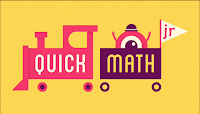So how are you doing? Ready to step back into the world of Fact Sheets about different ways of learning and thinking? I'm going to tackle two this week (and the good thing about online publishing is that it allows me to go back and change this!)
So here's the first one (I'm being pedantic by adding the Fact Sheets from understood.org as they appeared in the original email. The six Fact sheets are: Dyslexia (last post); ADHD; Dyscalculia; Slow Processing Speed; Sensory Processing; and DCD. I've linked all six in case you want to get ahead of me!
ADHD
I tackled this topic in several posts last year (!) so I won't spend any more time on it. My biggest concern for children is summed up in the statement above: ADHD isn't caused by laziness or lack of discipline. Too many children have been incorrectly and unfairly judged as lazy or undisciplined. The other concern falls under the Ways to help category - finding strategies for coping with anxiety.
Dyscalculia
Up to 7% of elementary school students have dyscalculia. Research suggests it's as common as dyslexia -- a reading disorder -- but not as well understood. In fact, kids and parents sometimes call it “math dyslexia,” but this can be confusing because dyscalculia is a completely different condition. Kids with dyscalculia may count on their fingers long after other children have stopped doing so.
How Can I Help My Child?
The following suggestions are from the website linked above. I've modified some of the ideas based on my experience.
Here are some things you can try to help your child better learn and understand math and lower her anxiety:
- Let her use her fingers and paper when she counts. My experience with students I suspect have dyscalculia is that their fingers move far faster than I can imagine. The problem with using fingers is that it eventually will not be as helpful when we're talking more difficult math problems.
- Make sure she has the right tools, like an easy-to-use calculator and plenty of erasers. It is really important to get the teacher's buy-in for this. It's also why it's important to have testing done to ensure that this is the appropriate diagnosis. And once you have that, you can have an IEP that will - should - allow these accommodations. I'd add that having a multiplication chart close by is a real asset as well. Have it laminated or put into a plastic sleeve and taped to your child's desk.
- Use graph paper. It helps keep columns and numbers straight and neat. This is really important and the bigger the grid the better because lots of children don't print small! This link is to 1/2 inch grid. This is 1 cm grid paper, perhaps more useful.
- Use rhythm and music to teach math facts and steps. I've worked with a student who had no problems with the algorithms (knowing how to add, multiply etc.) but could not remember the math facts. In fact, I started learning about dyscalculia after entering a search quest for: "Can't remember number facts" and up popped understood.org with information about dyscalculia.
- Get an experienced math tutor to help. I'm here!!
- Draw pictures of math word problems. This is a really important strategy and it reminds me that I should do a post about the different problem solving strategies!
- Schedule computer time to play math games. How's this - play x number of minutes on a math game/app to earn y number of minutes of another online game.
- Praise her hard work, not the outcome.
- Talk with her about her learning disability.
- Teach her ways to manage anxiety.
Some Math Game Apps
- Quick Math Jr is one of the best apps I've seen for younger kids (and kids struggling and needing confidence.) There is a free version; I purchased the upgrade. My students are most eager to play this game. Little side story - a few years ago when travelling in Italy, John and I stepped outside our comfort zone and as part of a package to get to know more about Italy, we had dinner with a family in Florence. The two young daughters did not have much English but I gave them my iPad and showed them the game. Within minutes they were playing away. Here's a link to a review.
- The big brother of Quick Math Jr is Quick Math. It's a drill app for all four operations. If your child is competitive this is a good game because it times how quickly you get through each set and then posts the score. It is leveled, so you can choose both the operation (addition, subtraction, multiplication, and division) as well as Beginner and up. I also like the fact that to answer the problems you have to 'write' with your finger directly on the screen so it encourages proper number formation. Unfortunately I cannot find the app on Google Play, only iOS. Beware - there are apps on Google Play called Quick Math but they are not from Shiny Things (the maker of Quick Math Jr and Quick Math).
- Finally, there are so many apps out there. Check out this page for reviews of Math apps on both iOS and Google Play. I have downloaded only the Quick Math so far but intend to add more using these recommendations. I'll keep you posted. Do not be put off by the reference to 4th Grade.
Just before we get to the January cartoons, here's a link from ADDitude magazine about Dyscalulia in Adults because it's not just for kids!















